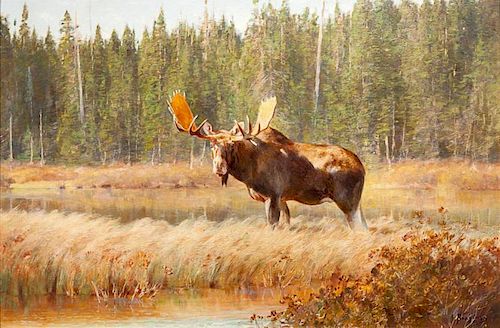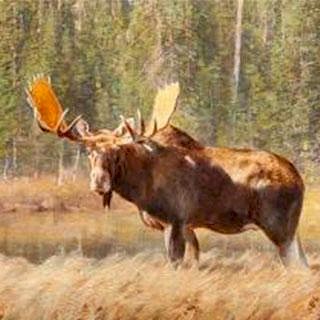Carl Clemens Moritz Rungius (1869-1959) Bull Moose
About Seller
20 Winter Street
Pembroke, MA 02359
United States
Founded in 2005, Copley Fine Art Auctions is a boutique auction house specializing in antique decoys and American, sporting, and wildlife paintings. Over the course of the last two decades, the firm has set auction records for not only individual decoy makers, but also entire carving regions. Copley...Read more
Two ways to bid:
- Leave a max absentee bid and the platform will bid on your behalf up to your maximum bid during the live auction.
- Bid live during the auction and your bids will be submitted real-time to the auctioneer.
Bid Increments
| Price | Bid Increment |
|---|---|
| $0 | $50 |
| $1,000 | $100 |
| $2,500 | $250 |
| $5,000 | $500 |
| $10,000 | $1,000 |
| $25,000 | $2,500 |
| $50,000 | $5,000 |
About Auction
Feb 12, 2016 - Feb 13, 2016
Copley Fine Art Auctions cinnie@copleyart.com
- Lot Description
Carl Clemens Moritz Rungius (1869-1959)
Bull Moose,1909
signed "C. Rungius" lower right
oil on canvas, 23 1/4 by 35 1/2in.
Carl Clemens Moritz Rungius was born in 1869 in Germany. He was trained classically in the German art tradition in Berlin, including at the Kunstakademie, during his early years. This, coupled with his compulsory military service in the Prussian army, gave him the artistic skills and marksmanship experience which fostered his illustrious career as a big game painter.
Rungius had extensive personal experience in the wild. His first trip to the United States in 1894 came at the invitation of an uncle to hunt moose in Maine. The expedition did not bag a moose, so Rungius stayed on for a year to try again the next season. In the course of that year, the artist completed his first substantial painting in the U.S., depicting a bull moose head. This work was displayed at M. Knoedler and Co. in New York and drew Rungius much acclaim.
The artist’s German roots and training in the German realist manner defined his early career. Rungius was unable to hunt big game in his native Europe due to the aristocratic restrictions on private game parks, so the wide open spaces of America beckoned strongly. Rungius settled permanently in America in 1897, and the romantic and aristocratic connotations of big game paintings are apparent in his work. His wildlife paintings spring directly from the tradition of Wilhelm Kuhnert and Edwin Landseer.
Theodore Roosevelt owned one of Rungius’s painting of a bull moose titled “Lord of the Forest.” The Glenbow Museum notes, “Rungius devoted more time to depicting moose than any other big game subject. Rungius's interpretation of the moose changed throughout his career, reflecting both his development as an artist and his changing attitude to wildlife.” Later he would inject more rugged, impressionist style and simplify his planes of color.
In 1904 while on an expedition in the Yukon, Rungius took a significant trophy moose. The moose ended up in the British Museum in London, and Rungius’s drawing of the notable specimen was published in Samuel Merrill’s 1916 volume “The Moose Book.”
This commanding painting hung in a prominent residence at the Adirondack League Club on Moose Lake and Moose River near Old Forge, New York. Founded in 1890 and now one of the oldest sporting clubs in the country, the Adirondack League is an over 50,000 acre retreat centered on hunting, fishing, and hiking with strong preservation and conservation principles. Its members have included architect Stanford White, President Warren G. Harding, and Gardiner Green Hubbard, who was the founder and first president of National Geographic Society, which today awards the Hubbard Medal in his honor.
"Bull Moose" is related to “Hunting the Canada Moose,” which can be found in the Glenbow Museum in Calgary, the major repository for Rungius’s works and the contents of his Banff studio. The Glenbow notes, “In later work, Rungius didn't include the hunter in his images, allowing for a more direct encounter with the animal.” This is apparent in "Bull Moose," where the subject gazes directly at the viewer. The realistic coloring and shadowing of the moose’s rack across his body emphasize the imposing size of the animal.
This classic big game painting by one of the most well-known painters of America’s native wild animals is a commanding centerpiece for any museum or private wildlife art collection. This marks the first time this signature Rungius has been offered for sale in over forty years.
Provenance: John P. Nicholson Collection, purchased from The Crossroads of Sport, Inc., New York, January 1975
Private Collection, by descent in the family
Literature: The Glenbow Museum, "Carl Rungius: Artist and Sportsman," Toronto, Canada, 2001. Samuel Merrill, “The Moose Book, Facts and Stories from Northern Forests,” New York, NY, 1916. The Crossroads of Sport, Inc. Catalog, New York, NY, 1974-1975, p. 61, illustrated.Condition
Condition report requests can be made via email or by telephone (info@copleyart.com or 617.536.0030). Any condition statement given is a courtesy to customers, Copley will not be held responsible for any errors or omissions. The absence of a condition statement does not imply that the lot is in perfect condition.
- Shipping Info
-
Shipping info
Copley Fine Art Auctions does not handle the shipping of any items. Shipping is the sole responsibility of the buyer. Once your payment has cleared, and we have received your authorized shipping release form items may be released for shipment. Copley Fine Art Auctions, LLC shall have no liability for any loss or damage to such items. Buyers should allow up to four weeks for shipment.PLEASE BE AWARE THAT INTERNET BIDDERS MAY NOT PICK UP THEIR ITEMS AT THE SALE SITE. ITEMS CAN BE PICKED UP BY APPOINTMENT OR SHIPPED STARTING FIVE DAYS AFTER THE CONCLUSION OF THE SALE
-
- Buyer's Premium



 EUR
EUR CAD
CAD AUD
AUD GBP
GBP MXN
MXN HKD
HKD CNY
CNY MYR
MYR SEK
SEK SGD
SGD CHF
CHF THB
THB















